
Adenophorea or Aphasmidia was a class of nematodes (roundworms). It has been by and large abandoned by modern taxonomy, because there is strong evidence for it being a motley paraphyletic group of unrelated lineages of roundworms. [1]

Adenophorea or Aphasmidia was a class of nematodes (roundworms). It has been by and large abandoned by modern taxonomy, because there is strong evidence for it being a motley paraphyletic group of unrelated lineages of roundworms. [1]
Amphids of Adenophoreas are always post-labial and pore-like.
Deirids are not seen in Adenophoreas.
Phasmids are also generally absent in Adenophoreas.
Adenophreas have uninucleate hypodermal glands.
Adenophoreas' excretory system is simple and non-tubular when present.
Adenophoreas commonly have three caudal glands. The opening is through a spinneret at the tail tip.
Male Adenophoreas generally have two testes.
Caudal alae are rare in Adenophoreas.
Male Adenophoreas have supplement glands situated in a single ventro-median row.
Sensory papillae of Adenophoreas are in the cephalic region and along the body.
Generally, Adenophoreas have five esophageal glands.
Adenophorea are either marine, freshwater or terrestrial or three of them together or any two of them.
A number of these traits above are plesiomorphic, and thus unsuitable to discern relationships.

The endocrine system is a messenger system in an organism comprising feedback loops of hormones that are released by internal glands directly into the circulatory system and that target and regulate distant organs. In vertebrates, the hypothalamus is the neural control center for all endocrine systems.

Skunks are mammals in the family Mephitidae. They are known for their ability to spray a liquid with a strong, unpleasant scent from their anal glands. Different species of skunk vary in appearance from black-and-white to brown, cream or ginger colored, but all have warning coloration.

A mammary gland is an exocrine gland in humans and other mammals that produces milk to feed young offspring. Mammals get their name from the Latin word mamma, "breast". The mammary glands are arranged in organs such as the breasts in primates, the udder in ruminants, and the dugs of other animals. Lactorrhea, the occasional production of milk by the glands, can occur in any mammal, but in most mammals, lactation, the production of enough milk for nursing, occurs only in phenotypic females who have gestated in recent months or years. It is directed by hormonal guidance from sex steroids. In a few mammalian species, male lactation can occur. With humans, male lactation can occur only under specific circumstances.

Musk deer can refer to any one, or all eight, of the species that make up Moschus, the only extant genus of the family Moschidae. Despite being commonly called deer, they are not true deer belonging to the family Cervidae, but rather their family is closely related to Bovidae, the group that contains antelopes, bovines, sheep, and goats. The musk deer family differs from cervids, or true deer, by lacking antlers and preorbital glands also, possessing only a single pair of teats, a gallbladder, a caudal gland, a pair of canine tusks and—of particular economic importance to humans—a musk gland.

The dromedary, also known as the dromedary camel, Arabian camel, or one-humped camel, is a large camel, of the genus Camelus, with one hump on its back.

Wuchereria bancrofti is a filarial (arthropod-borne) nematode (roundworm) that is the major cause of lymphatic filariasis. It is one of the three parasitic worms, together with Brugia malayi and B. timori, that infect the lymphatic system to cause lymphatic filariasis. These filarial worms are spread by a variety of mosquito vector species. W. bancrofti is the most prevalent of the three and affects over 120 million people, primarily in Central Africa and the Nile delta, South and Central America, the tropical regions of Asia including southern China, and the Pacific islands. If left untreated, the infection can develop into lymphatic filariasis. In rare conditions, it also causes tropical pulmonary eosinophilia. No vaccine is commercially available, but high rates of cure have been achieved with various antifilarial regimens, and lymphatic filariasis is the target of the World Health Organization Global Program to Eliminate Lymphatic Filariasis with the aim to eradicate the disease as a public-health problem by 2020. However, this goal was not met by 2020.
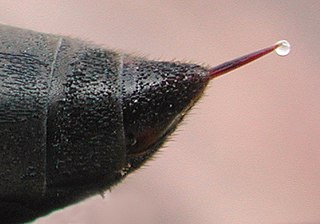
A stinger is a sharp organ found in various animals capable of injecting venom, usually by piercing the epidermis of another animal.
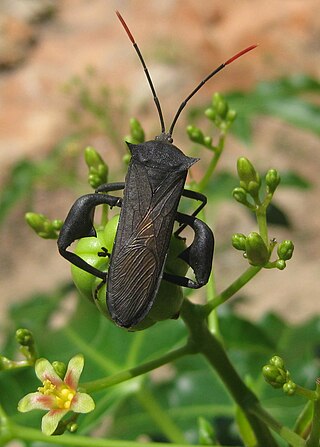
Coreidae is a large family of predominantly sap-sucking insects in the Hemipteran suborder Heteroptera. The name "Coreidae" derives from the genus Coreus, which derives from the Ancient Greek κόρις (kóris) meaning bedbug.

Secernentea was a class of nematodes in the Classical Phylogeny System and is no longer in use. This morphological-based classification system has been replaced by the Modern Phylogeny system, where taxonomy assignment is based on small subunit ribosomal DNA.

The mammary ridge or mammary crest is a primordium specific for the development of mammary glands.

The Siberian musk deer is a musk deer found in the mountain forests of Northeast Asia. It is most common in the taiga of southern Siberia, but is also found in parts of Mongolia, Inner Mongolia, Manchuria and the Korean peninsula.
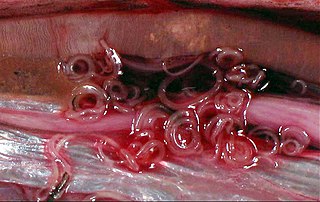
The Chromadorea are a class of the roundworm phylum, Nematoda. They contain a single subclass (Chromadoria) and several orders. With such a redundant arrangement, the Chromadoria are liable to be divided if the orders are found to form several clades, or abandoned if they are found to constitute a single radiation.
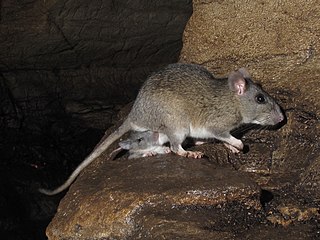
The Allegheny woodrat, is a species of "pack rat" in the genus Neotoma. Once believed to be a subspecies of the eastern woodrat, extensive DNA analysis has proven it to be a distinct species.

Glandulocaudinae are a subfamily of tropical freshwater characin fish from Central and South America. In all species of this subfamily, a gland on their caudal fin is found almost exclusively in the males, which allows the release and pumping of pheromones; also, members of this subfamily have complex courtship behaviors which lead to insemination. The ecology and life history of these fish is complex yet little studied. Glandulocaudines are important as food fish for larger fish important for commercial and subsistence reasons.
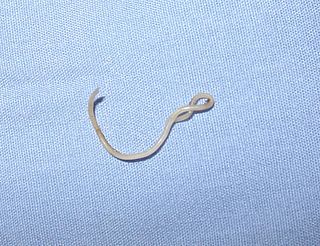
Toxocara canis is a worldwide-distributed helminth parasite that primarily infects dogs and other canids, but can also infect other animals including humans. The name is derived from the Greek word "toxon," meaning bow or quiver, and the Latin word "caro," meaning flesh. T. canis live in the small intestine of the definitive host. This parasite is very common in puppies and somewhat less common in adult dogs. In adult dogs, infection is usually asymptomatic but may be characterized by diarrhea. By contrast, untreated infection with Toxocara canis can be fatal in puppies, causing diarrhea, vomiting, pneumonia, enlarged abdomen, flatulence, poor growth rate, and other complications.

The yellow-spotted rock hyrax or bush hyrax is a species of mammal in the family Procaviidae. It is found in Angola, Botswana, Burundi, the Democratic Republic of the Congo, southern Egypt, Eritrea, Ethiopia, Kenya, Malawi, Mozambique, Rwanda, Somalia, northern South Africa, South Sudan, Sudan, Tanzania, Uganda, Zambia, and Zimbabwe. Its natural habitats are dry savanna and rocky areas. Hyrax comes from the Greek word ὕραξ, or shrew-mouse.

The nematodes, roundworms or eelworms constitute the phylum Nematoda. They are a diverse animal phylum inhabiting a broad range of environments. Most species are free-living, feeding on microorganisms, but many species are parasitic. The parasitic worms (helminths) are the cause of soil-transmitted helminthiases.
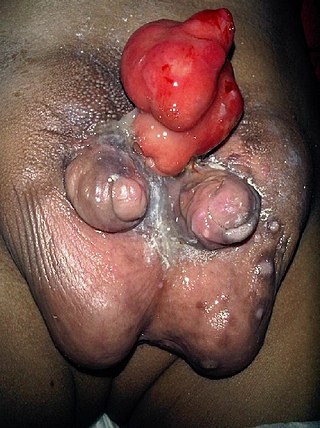
Diphallia, penile duplication (PD), diphallic terata, or diphallasparatus is an extremely rare developmental abnormality in which a male is born with two penises. The first reported case was by Johannes Jacob Wecker in 1609. Its occurrence is 1 in 5.5 million boys in the United States.
Eustrongylidosis is a parasitic disease that mainly affects wading birds worldwide; however, the parasite's complex, indirect lifecycle involves other species, such as aquatic worms and fish. Moreover, this disease is zoonotic, which means the parasite can transmit disease from animals to humans. Eustrongylidosis is named after the causative agent Eustrongylides, and typically occurs in eutrophicated waters where concentrations of nutrients and minerals are high enough to provide ideal conditions for the parasite to thrive and persist. Because eutrophication has become a common issue due to agricultural runoff and urban development, cases of eustrongylidosis are becoming prevalent and hard to control. Eustrongylidosis can be diagnosed before or after death by observing behavior and clinical signs, and performing fecal flotations and necropsies. Methods to control it include preventing eutrophication and providing hosts with uninfected food sources in aquaculture farms. Parasites are known to be indicators of environmental health and stability, so should be studied further to better understand the parasite's lifecycle and how it affects predator-prey interactions and improve conservation efforts.

Brugia is a genus for a group of small roundworms. They are among roundworms that cause the parasitic disease filariasis. Specifically, of the three species known, Brugia malayi and Brugia timori cause lymphatic filariasis in humans; and Brugia pahangi and Brugia patei infect domestic cats, dogs and other animals. They are transmitted by the bite of mosquitos.
![]() Data related to Adenophorea at Wikispecies
Data related to Adenophorea at Wikispecies